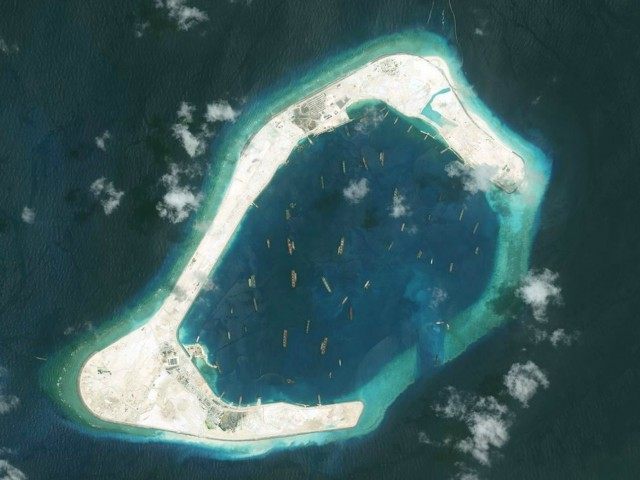Satellite images of construction in the South China Sea indicate the Chinese government has begun construction on three new airstrikes near the Spratly and Paracel Islands, quadrupling its presence in the highly-contested maritime territory.
According to a new report from the Associated Press, construction has begun on what appear to be three new artificial jet landing strips in the Spratly Islands, claimed by the Philippines as well as China. The Chinese military has completed an operational landing strip on Woody Island in the Paracel Islands, claimed by Vietnam, as well. The AP notes that images indicate that the artificial islands are nearly complete, allowing for the beginning of construction of “buildings, harbors and, most importantly, runways.”
China has proclaimed itself sovereign over most of the South China Sea, a lucrative seaway contested by China, Vietnam, the Philippines, Malaysia, Brunei, and Taiwan. The other contender nations have traditionally shared use of the territory to exploit its natural resources, particularly fishing and potential fuel deposits, as well as its use for transportation purposes. China’s declaration that, thanks to an inheritance “from our ancestors,” other nations may not freely transit in this body of water have caused significant alarm not just among southern Asian neighbors, but internationally.
Perhaps most concerning in the AP report is a statement from Defense Ministry spokesman Wu Qian, who told reprters on Sunday that military construction on the islands was to be used “purely for defensive purposes.” This contradicts previous Chinese government statements that none of the construction China is executing in the region is for military use at all. Chinese officials have claimed the facilities constructed on reefs in the Spratly and Paracel Islands are to be used in monitoring weather and civilian rescue operations. A report in the South China Morning Post recently indicated that the Chinese government was also building “wave farms” to generate energy for its facilities on the new islands.
Neighboring countries have found this civilian claim difficult to believe, and the government of the Philippines has lodged a complaint at the International Court of Arbitration at the Hague, requesting an official decree regarding the use of the South China Sea. The Chinese government has responded by vowing to ignore any statement released by the Hague. “China has on several occasions stated that the Arbitral Tribunal established at the request of the Philippines has no jurisdiction over the case,” Foreign Ministry spokesperson Hua Chunying said last week.
Other claimant nations to the South China Sea territories have supported the Philippines, and even non-claimant nations like Indonesia have expressed a desire to see the dispute in an international court.
Still others have issued new policies allowing for a greater American presence in the region. According to a Foreign Policy report published today, the government of Singapore has recently issued the United States enhanced permission to fly surveillance missions out of territory it controls, giving the U.S. easier access to the South China Sea. The new agreement “reflects Singapore’s concerns over China’s assertive stance on territorial disputes. It also points to a broader trend among countries in the region to seek out the United States as a counterweight to China’s expansionist moves in the contested waterway,” the report claims.
The United States has made its presence known in the region. In October, the USS Lassen, a missile destroyer, conducted a “freedom of navigation” exercise in the South China Sea widely condemned by various sectors of the Chinese communist government. Shortly following the series of public statements from the Chinese foreign ministry, U.S. Secretary of Defense Ashton Carter personally sailed through the South China Sea with his Malaysian counterpart, Hidhammuddin Hussein.

COMMENTS
Please let us know if you're having issues with commenting.